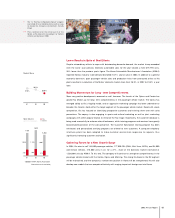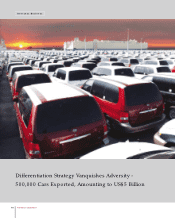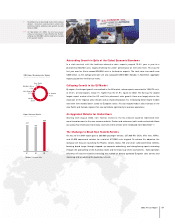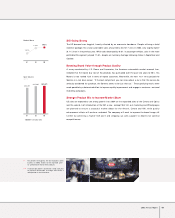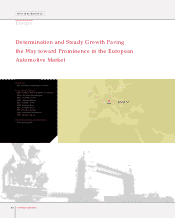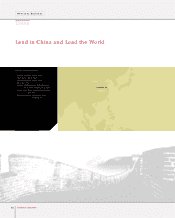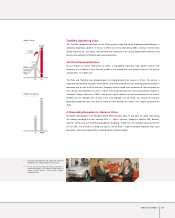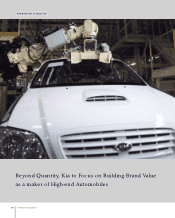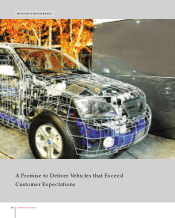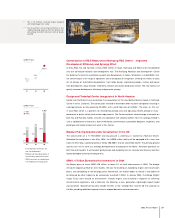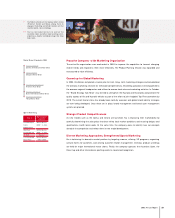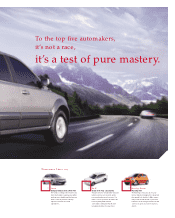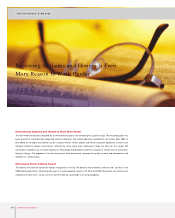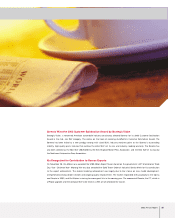Kia 2003 Annual Report Download - page 25
Download and view the complete annual report
Please find page 25 of the 2003 Kia annual report below. You can navigate through the pages in the report by either clicking on the pages listed below, or by using the keyword search tool below to find specific information within the annual report.
2003 Annual Report 25
Slight Decline in Overall Output, but Stepped up Sorento Sales
Kia Motors’ three domestic plants boast an annual output capacity of 1,150,000 units, but actual
production for 2003 was 852,598 units, down 2.2% year on year. The total breaks down as 280,640 at
Sohari, 427,595 at Hwasung plant, and 144,363 at Gwangju. The plants operated at 74% of total
capacity, slightly lower than in 2002. Major factors contributing to this drop in output were, sluggish
domestic sales throughout the year; readjusting output at the Gwangju plant to 300,000 units in the
wake of the July-August strike; resource allocations needed to launch new models; production delays
during wage negotiations; and the introduction of a 40-hour workweek.
However, positive changes have also been made at the Kia plants in 2003. Utilization rate of the Line 1 at
Hwasung has increased from 40 units per hour to 44.4, enabling the company to accommodate
increased demand for the Sorento. Lines 2 and 3 at Hwasung are now fully ready for mass production of
the Cerato and Opirus. Importantly, the quality index has improved throughout production operations,
and receipt of ISO 14001 certification by all three plants has bolstered the corporate image related to
environmental protection.
High Quality Assessment Received Overseas
Ongoing quality improvement efforts have resulted in highly positive ratings for Kia vehicles from
numerous overseas automobile evaluation organizations. The Sorento was ranked first among 12 mid-
sized SUV models covered in an AutoPacific vehicle satisfaction survey of American consumers (results
released in May 2003). The Kia SUV also topped a total quality index study conducted by Strategic Vision
(results released in June) in the mid-sized SUV category. The Carnival, meanwhile, was ranked third
among 13 models surveyed.
The quality of Kia products has been clearly recognized. An IQS survey by J.D.Power and Associates
included an assessment that said Kia Motors had achieved the most extensive quality enhancement over
the past two years. Specifically noted were the consistant quality of components and improvement in
adherence to basic quality standards. Kia officials are confident the outstanding quality of new models
recently introduced will further boost the company’s quality ratings in 2004.
Output Capacity Stepped Up and Operation Rate M ade M ore Efficient
The expansion of the Gwangju plant capacity from 210,000 units to 350,000 units and raised total
annual output capability to 1,250,000 units. The company expects to produce 992,000 vehicles in 2004,
which would be an operation rate of 80% . Moreover, Donghee Auto, a partner with a plant in Seosan,
Korea capable of turning out up to 150,000 units a year, will be commissioned to build 110,000 units of
the Morning, one of Kia’s latest models, in 2003. Kia’s goal is to reach the pinnacle of operations
performance in the world automobile industry, by 2007.
▶Customer satisfaction has improved after Kia
implemented various pre-shipment procedures to
ensure new cars are delivered at their very best.
▶▶ The Namyang Research and Development Center,
jointly operated by Kia Motors and Hyundai Motor,
has made quality enhancement its top priority.
The state-of-the-art facility boasts some of the
best engineers in the business.
∙
Annual Full Capacity 1,150,000 Units
∙
OEM Included
Hwasung 600,000 units
▶’03 : 427,595 Units
Gwangju 210,000 units
▶’03 : 144,363 Units
Sohari 340,000 units
▶’03 : 280,640 Units
∙
FY03 Donghee Automotive production
excluded
Utilization Rate
74%
76%
74%
01 02 03
Production
(Units)
851,740
872,086 852,598
01 02 03
Production Capacity


